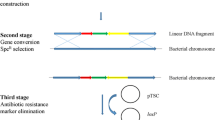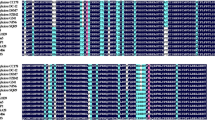Summary
A pUB110-derived plasmid/Bacillus subtilis host combination was segregationally unstable when grown in chemostat culture with complex or minimal medium and under starch, glucose or magnesium limitation. The kinetics of plasmid loss were described in terms of the difference in growth rates between plasmid-containing and plasmid-free cells (dμ) and the rate at which plasmid-free cells were generated from plasmid-containing cells (R). Loss of plasmid-containing cells from the population was dμ dominated. Changes in medium composition and the nature of growth limitation caused variations in both dμ and R. The plasmid was most stable in glucose-limited chemostat cultures with minimal medium and least stable under starch limitation with complex complex medium. R and dμ were smaller for cultures in complex media than those in minimal media. Limitation by starch induced expression of the plasmid-encoded HT α amylase gene and was associated with increased values of R and dμ. Magnesium limitation in minimal medium caused a significant increase in dμ and a decrease in R.
Similar content being viewed by others
Abbreviations
- Cm:
-
chloramphenicol
- Kan:
-
kanamycin
- Cmr :
-
cells resistant to chloramphenicol (5 mg L−1)
- Kanr :
-
cells resistant to kanamycin (5 mg L−1)
- CmsKans :
-
cells sensitive to chloramphenicol and kanamycin
References
Anagnostopolous, C. and J. Spizizen. 1961. Requirements for transformation inBacillus subtilis. J. Bact. 81: 741–746.
Bentley, W.E. and D.S. Kompala. 1989. A novel structured kinetic modelling approach for the analysis of plasmid instability in recombinant bacterial cultures. Biotechnol. Bioeng. 33: 49–61.
Bentley, W.E. and D.S. Kompla. 1990. Stability in continous cultures of recombinant bacteria. Biotech. Lett. 12: 329–334.
Betenbaugh, M.J., C. Beaty and P. Dhurjati. 1987. Growth kinetics ofEscherichia coli containing temperature-sensitive plasmid pOU140. Biotechnol. Bieng. 3: 1425–1436.
Bron, S. and E. Luxen. 1985. Segegational instability of pUB110-derived recombinant plasmids inBacillus subtilis. Plasmid. 14: 235–244.
Bron, S., P. Bosma, M. van Belkum and E. Luxen. 1987. Stability function in theBacillus subtilis plasmid pTA1060. Plasmid. 18: 8–15.
Caulcott, C.A., G. Liley, E.M. Wright, M.K. Robinson and G.T. Yarranton. 1985. Investigation of the instability of plasmids during the expression of Met-prochymosin inEscherichia coli. J. Gen. Microbiol. 131: 3355–3365.
Cooper, N.S., M.E. Brown and C.A. Caulcott. 1987. A mathematical method for analyzing plasmid stability in microorganisms. J. Gen. Microbiol. 133: 1871–1880.
Doi, R.H. 1984. Genetic engineering inBacillus subtilis. In: Biotechnology and Genetic Engineering Reviews (Russell, G.E., ed.), pp. 121–135. Intercept, UK.
Ensley, B.D. 1986. Stability of recombinant plasmids in industrial microorganisms. CRC Crit. Rev. in Biotechnol. 4: 263–277.
Fleming, G., M.T. Dawson and J.W. Patching. 1988. The isolation of strains ofBacillus subtilis showing improved plasmid stability characteristics by means of selective cheostat culture. J. Gen. Microbiol. 134: 2059–2101.
Godwin, D. and J.H. Slater. 1979. The influence of the growth environment on the stability of a drug resistance plasmid inEscherichia coli K12. J. Gen. Microbiol. 111: 201–210.
Goldberg, I. and Z. Er-El. 1981. The chemostat — an efficient technique for medium optimization. Proc. Biochem. 16: 2–8.
Gruss, A.D. and S.D. Ehrlich. 1989. The family of highly interrelated single-stranded deoxyribonucleic acid plasmids. Microbiol. Rev. 53: 231–241.
Gryczan, T., A.G. Shivakumar and D. Dubnau. 1980. Characterization of chimeric plasmid cloning vehicles inBacillus subtilis. J. Bacteriol. 141: 245–253.
Imanaka, T. and S. Aiba. 1981. A perspective on the application of genetic engineering: stability of recombinant plasmids. Proc. N.Y. Acad. Science 10: 1–14.
Kadam, K.L., K.L. Wollbirer, J.C. Grosch and Y.C. Jao. 1987. Investigation of plasmid instability in an amylase-producingBacillus subtilis using continous culture. Biotechnol. Bioeng. 24: 859–872.
Koizumi, J., Y. Monden and S. Aiba. 1985. Effects of temperature and dilution rate on the copy number of a recombinant plasmid in continuous culture ofBacillus stearothermophilus (pLP11). Biotechnol. Bioeng. 27: 721–728.
Lee, S.B., A. Seressiotis and J.E. Bailey. 1985. A kinetic model for product formation in unstable recombinant organisms. Biotechnol. Bioeng. 27: 1699–1709.
Matsui, T., H. Sato, S. Mukataka and J. Tanaka. 1990. Effects of nutritional conditions on plasmid stability and production of tryptophan by a recombinantEscherichia coli. Agric. Biol. Chem. 54(b): 619–624.
Meacock, P.A. and S.N. Cohen. 1980. Partitioning of bacterial plasmids during cell division: acis-acting locus that accomplishes stable plasmid inheritance. Cell 20: 529–542.
Monod, J. 1950. La technique de cultière continué: theorie et applications. Ann. Inst. Pasteur Paris 79: 380–410.
Novick, R.P., A.D. Gruss, S.K. Highlander, M.L. Gennaro, S.J. Projan and H.F. Ross. 1986. Host-plasmid interactions affecting plasmid replication and maintenance in Gram-positive bacteria. In: Genes, Ecology, Transfer and Expression. Twentyfourth Branbury report (Levey, S.B. and R.P. Novick, eds), pp. 225–245, Cold Spring Harbor Laboratory Publications, USA.
Nugent, M.E., S.B. Primrose and W.C.A. Tacon. 1983. The stability of recombinant DNA. In: Developments in Industrial Microbiology 24 (Nash, C.H. and A. Lelens, eds), pp. 271–285, Soc. for Gen. Microbiol., J.D. Lucas Ltd, USA.
Ortlepp, S.A., J.F. Ollington and D.J. McConnell. 1983. Molecular cloning inBacillus subtilis of aBacillus licheniformis gene coding thermostable alpha amylase. Gene 23: 267–276.
Park, R. and D.D.Y. Ryu. 1990. Effect of operating parameters on the specific production rate of a cloned gene product and performance of the recombinant fermentation process. Biotechnol. Bioeng. 35: 287–295.
Reinikainen, P. and I. Virkajarvi. 1989.Escherichia coli growth and plasmid copy numbers in continous cultivations. Biotechnol. Lett. 11: 225–230.
Seo, J. and J.E. Bailey. 1985. A segregated model for plasmid content and product synthesis in unstable binary fission recombinant organisms. Biotechnol. Bioeng. 27: 156–165.
Shoham, Y. and A.L. Demain. 1990. Effect of medium composition on the maintenance of a recombinant plasmid inBacillus subtilis. Enzyme Microb. Technol. 12: 330–336.
Shoham, Y. and A.L. Demain. 1991. Kinetics of loss of a recombinant plasmid inBacillus subtilis. Biotechnol. Bioeng. 37: 927–935.
Stanstedt, R.M., E. Kneen and M.S. Blish. 1939. A standardized Wohlgemuth procedure for alpha amylase activity. Cereal Chem. 16: 712–723.
Vehmaanpera, J.O. and M.P. Korhola. 1986. Stability of the recombinant plasmid carrying theBacillus amyloliquefaciens α amylase gene inBacillus subtilis. Appl. Microbiol. Biotechnol. 23: 456–459.
Weber, A.E. and K.Y. San. 1990. Population dynamics of a recombinant culture in a chemostat under prolonged cultivation. Biotechnol. Bioeng. 6: 1104–1113.
Wei, D., S.J. Parulekar, B.C. Stark and W.A. Weigand. 1989. Plasmid stability and α amylase production in batch and continuous cultures ofBacillus subtilis Tn106 (pAT5). Biotechnol. Bioeng. 33: 1010–1020.
Wouters, J.T.M., F.L. Driehuis, P.J. Polaczek, M.L. van Oppenraay and J.G. van Andel. 1980. Persistance of the pBR322 plasmid inEscherichia coli K12 grown in chemostat cultures. Antonie von Leeuwenhoek 46: 353–362.
Author information
Authors and Affiliations
Rights and permissions
About this article
Cite this article
Fleming, G.T., Patching, J.W. Plasmid instability in an industrial strain ofBacillus subtilis grown in chemostat culture. Journal of Industrial Microbiology 13, 106–111 (1994). https://doi.org/10.1007/BF01584107
Received:
Accepted:
Issue Date:
DOI: https://doi.org/10.1007/BF01584107




